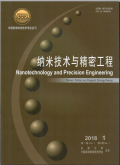摘要:以原子力显微镜(AFM)为加工工具进行了纳米级加工实验,对不同加工条件下的材料去除过程和切屑形态进行了研究.切屑形态通过扫描电子显微镜(SEM)进行观察,分析了不同垂直载荷、循环次数和针尖加工方向下铝铜被加工表面的切屑形成过程.实验结果表明:低裁下切屑呈细小断屑,散布在加工区域周围;随着垂直载荷的增加,切屑逐渐变成连续的带状切屑.不同循环次数、针尖加工面对切屑形成都有很大影响.在此基础上,对比分析了相同实验条件下,不同力学性能材料的切屑形成过程.最后,通过检测被加工表面得出被加工表面质量与切屑的数量和形态之间的关系,提出了改善被加工表面质量的方法,以帮助人们更好地理解基于AFM的纳米级加工技术.%Nanomachining experiments were conducted using atomic force microscopy(AFM)to investigate the influences of different machined conditions on chip formation and material removal.Chip behaviors were analyzed using scanning electron microscope(SEM),to study the effects of applied load,SCan cycles and scanning direction on nanomachining of Al and Cu samples.Results indicate that the chips produced at low applied the debris appears to be of continuous ribbon-like cutting-type.The influence of the tip faced forward during was also conducted on Al surface.The experimental results show that increasing the number of machining cycles affects the chip behaviors.In addition,the revolution of chip behaviors to applied loads is more obvious the number and size of cutting-type particles Can be concluded to help to develop better understanding of AFM nanomachining technique.The way to improve the surface quality of nanomachining was also given.

